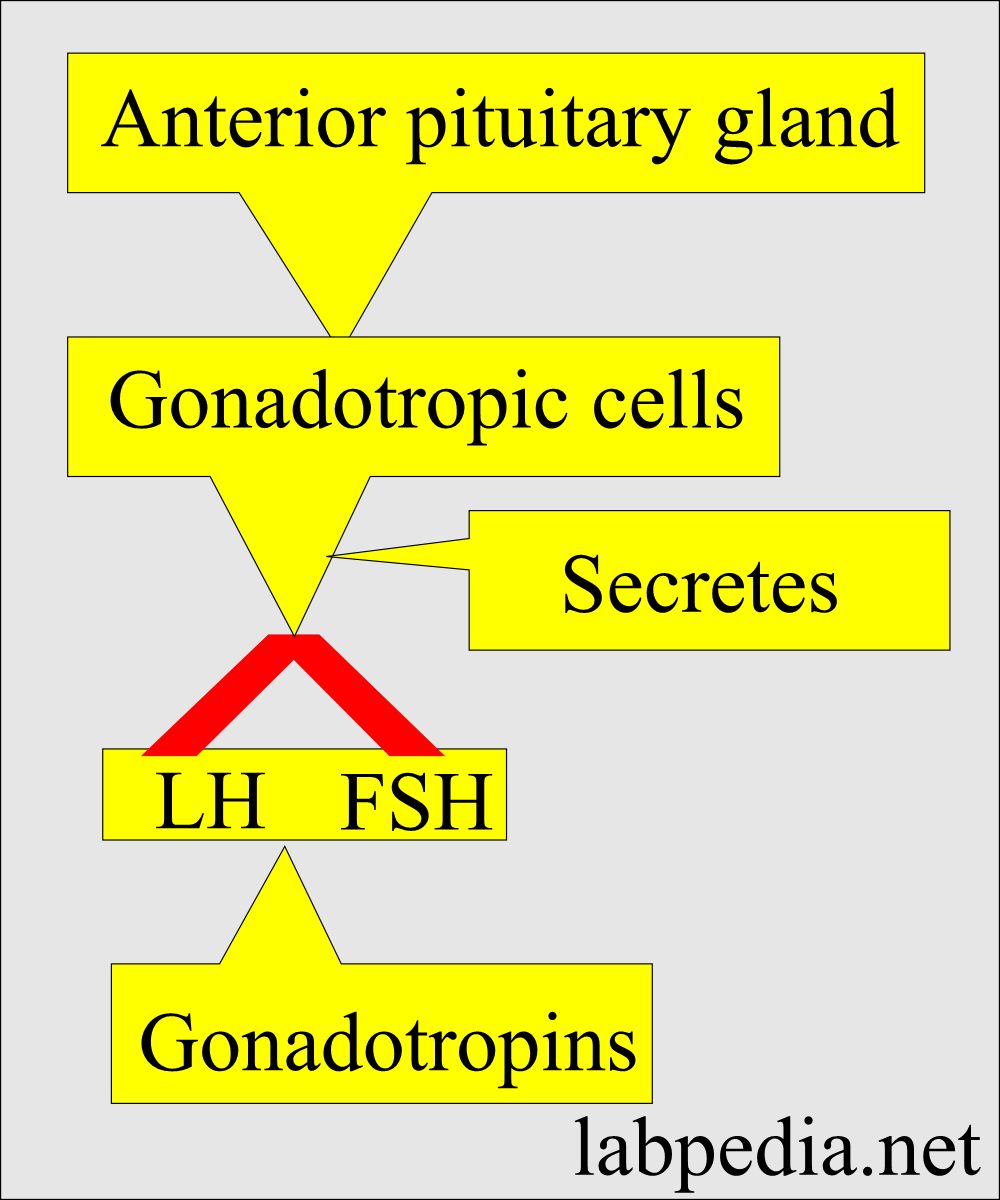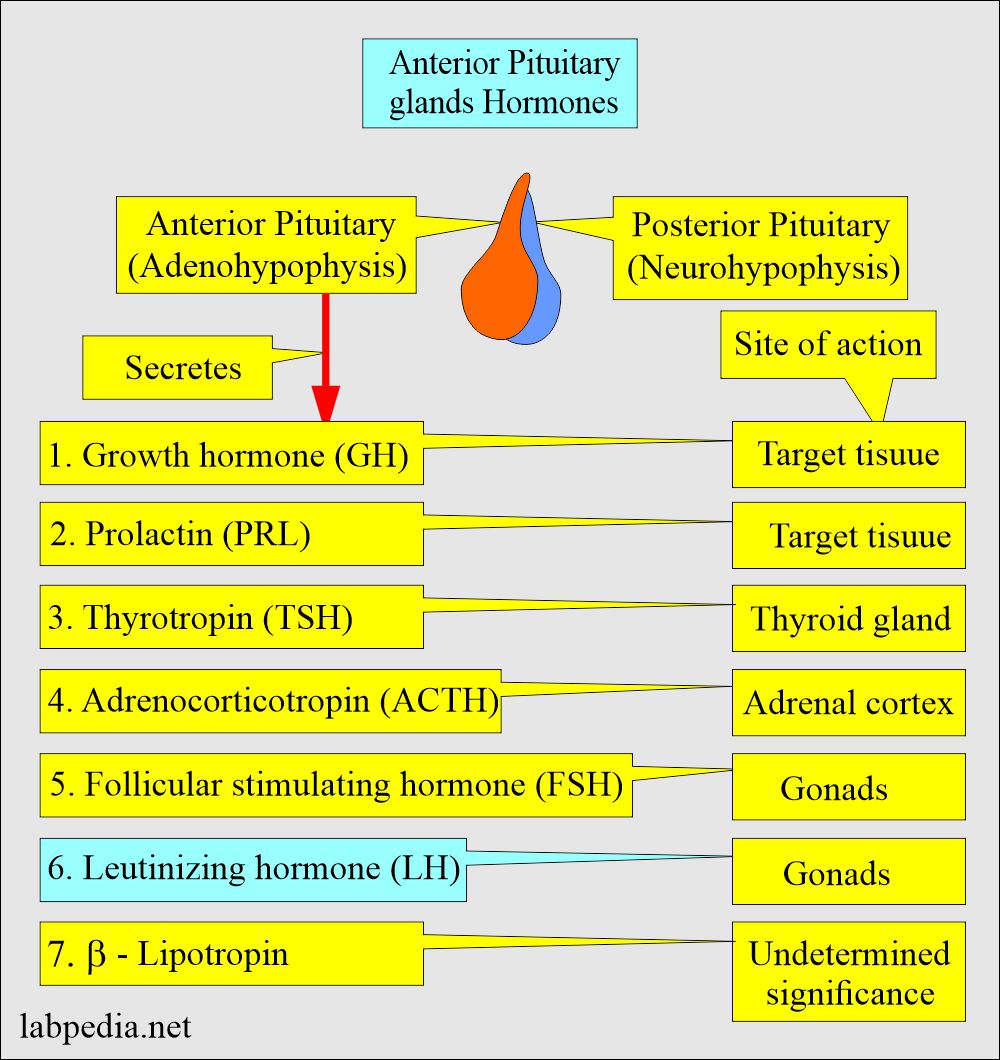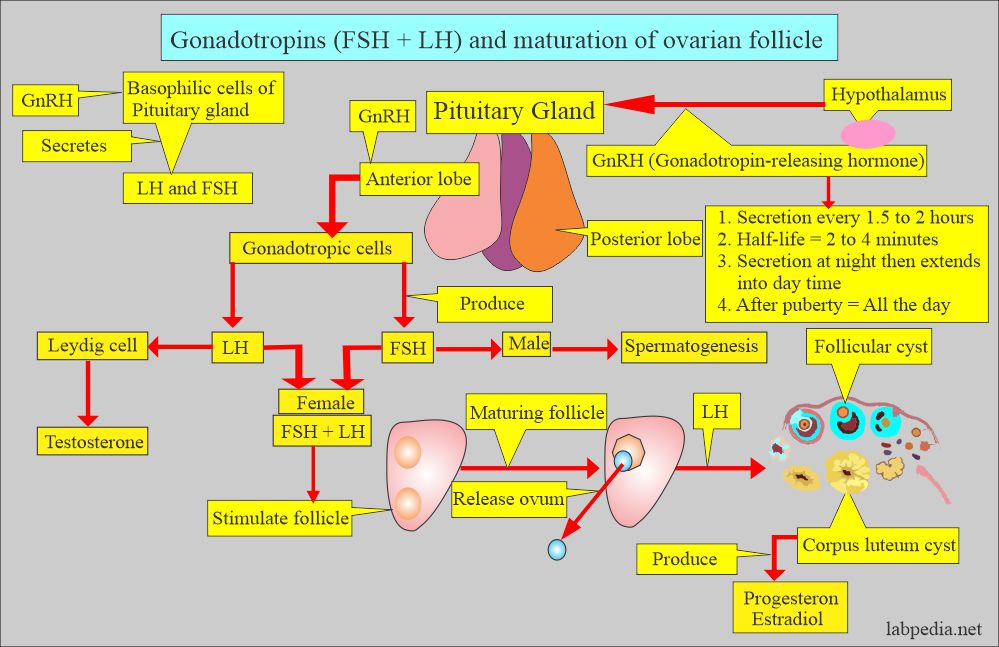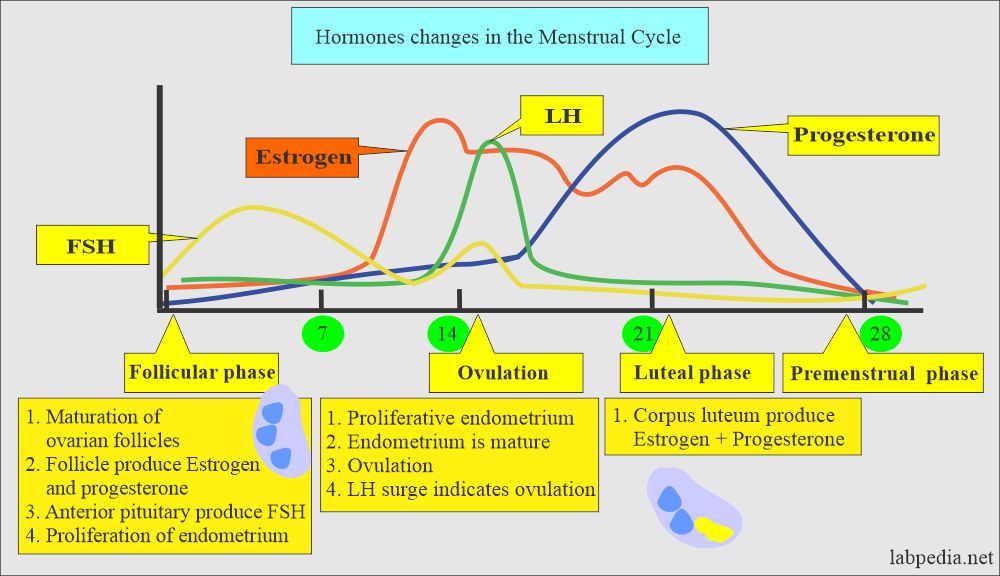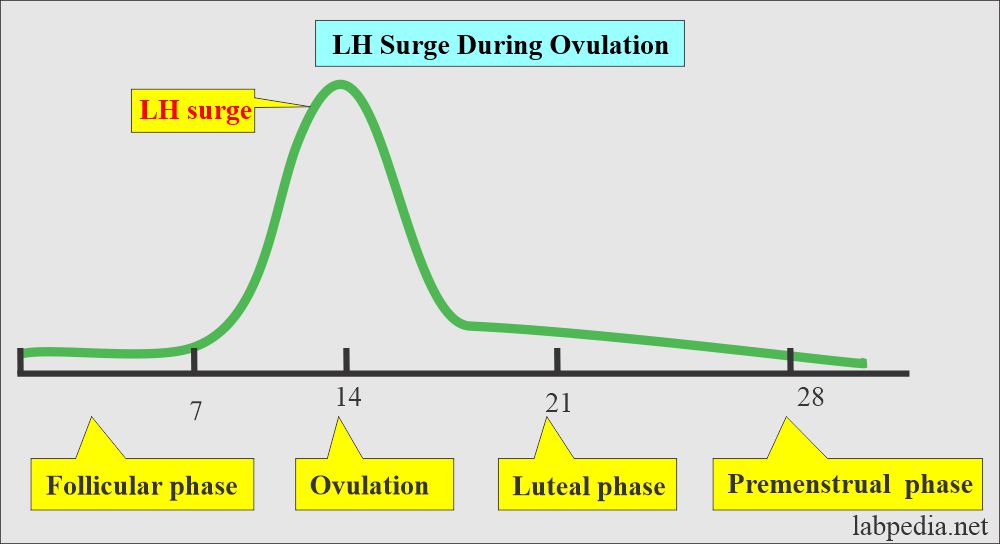Luteinizing Hormone (LH), Lutropin
Luteinizing Hormone (LH)
What sample is needed for Luteinizing Hormone (LH)?
- The serum of the patient is required.
- Avoid hemolysis.
- A 24-hour urine sample may be collected. Refrigerate the urine during collection.
- The serum is stable for 8 days at room temperature.
- The serum is stable for 14 days at 4 °C.
- The urine sample should not contain preservatives.
What are the Indications for Luteinizing Hormone (LH)?
- LH, along with FSH, helps determine menopause.
- LH is helpful in evaluating gonadal failure.
- LH helps work up infertility cases.
- LH’s essay tells about the occurrence of ovulation.
- It tells gonadal failure (insufficiency):
- Primary when the problem is in the ovary (or the testes).
- Secondary when the problem is in the pituitary insufficiency.
What are the precautions for Luteinizing Hormone (LH)?
- Some drugs that increase the LH value include Clomiphene, anticonvulsant, and spironolactone.
- A few drugs decrease the LH, estrogen level, Testosterone, Progesterone, oral contraceptives, Digoxin, and Phenothiazine.
- Patients with HCG-producing tumors and Hypothyroidism may give a false increased level.
- Avoid lipemic, hemolyzed, or icteric serum.
How will you discuss the pathophysiology of Luteinizing Hormone (LH)?
- LH and FSH are glycoproteins produced in the anterior pituitary gland.
- The placenta also produces the LH hormone.
- LH has a half-life of one hour.
- LH release is stimulated by the gonadotropin-releasing hormone (GTRH).
- Because of the feedback mechanism, estrogen and testosterone inhibit the production of LH and FSH.
- LH production is suppressed during the luteal phase by negative feedback from the progesterone combined with estradiol, but a low level of LH is necessary for prolonged corpus luteum function.
- LH and FSH hormones act on the ovary and testes and are called gonadotropins.
- GTRH (gonadotropins-releasing hormone) is stimulated by a low estrogen level in females and testosterone in males.
- The hypothalamus produces GTRH.
- Both hormones (LH and FSH) acting on the ovary and testes:
- In females, FSH stimulates the development of follicles in the ovary.
- LH stimulates estrogen production from the follicle.
- LH stimulates testosterone from the Leydig cells.
- Gonadal function tests are used for:
- In males: Hypogonadism.
- In females:
- Menstrual disorders.
- Fertility problems.
- Hirsutism or virilization.
- LH stimulates in the female follicular (ovary) production of:
- Estrogen.
- Ovulation.
- Formation of corpus luteum cyst.
- LH in males stimulates Leydig cells to produce testosterone.
- LH has a role in the menstrual cycle, giving midcycle surge.
- LH stimulates the corpus luteum formation, which supports an embryo in case of fertilization.
How will you discuss the Menstrual cycle?
- The hypothalamus produces GTRH, which acts on the anterior pituitary glands, which produce LH and FSH.
- There are cyclical hormonal changes in the ovary and the uterus.
- Changes in the ovary are:
- Follicular maturation.
- Ovulation.
- Formation of corpus luteum.
- Changes in the uterus are:
- Preparation of the endometrium for the implantation of the ovum.
- The vagina and cervix are prepared to allow the transfer of sperm.
What are the Hormonal changes in the menstrual cycle?
| Phase of Cycle | LH IU/L | FSH IU/L | Progesterone | Estradiol |
| Early follicular phase | low | raised | low | low |
| Late follicular phase | High = 1.68 to 15 | low = 1.37 to 9.9 | lower limit = <50 ng/dL | high = 20 to 350 pg/mL |
| Mid-cycle | Peak = 21.9 to 56.6 | raised = 6.17 to 17.2 | increasing | high = 150 to 750 pg/mL |
| Luteal phase | low = 0.61 to 16.3 | low = 1.09 to 9.2 | increasing = 300 to 2500 ng/dL | increasing = 30 to 450 pg/mL |
| Start of Next cycle | low | rising | rising | rising |
- FSH is needed for the maturation of the ovary and testes.
- FSH helps in the development of the follicles in the ovary.
- FSH stimulates the Sertoli cells in the male.
- LH and FSH are important for the production of sperm.
- LH is necessary for ovulation and corpus luteum formation.
- LH is secreted in a variable amount each day, so one value will not indicate the actual body hormone level.
- So several samples are taken, these are pooled, or all the samples are tested for LH.
- A raised level of LH and FSH indicates primary gonadal failure like a polycystic ovary or menopause.
- In gonadal failure due to the pituitary gland, LH and FSH levels are low.
What is the Spot urine test, and what is its significance?
- Spot urine test to detect LH surge is used to evaluate and treat infertility.
- This indicates the period when women are most fertile.
- LH surge precedes 24 hours of ovulation and can be recognized easily.
- A urine 24-hour sample is a better choice to avoid this variable amount of secretion of LH.
- LH assay can give a better idea of ovulation. There will be a surge in the LH level.
- The best sample is from 11 am to 3 pm.
- LH surge gives a peak fertility period, which is due to ovulation.
- LH surge is between 12 to 16 days of the cycle.
- This surge can be found by taking a daily sample near the midcycle.
What are the normal values of Luteinizing Hormone (LH)?
Source 1
| Age | Male mIU/mL | Female mIU/mL |
| Prepubertal child | ||
| Cord blood | 0.04 to 2.6 | 0.04 to 2.6 |
| 2 to 11 month | 0.02 to 8.0 | 0.02 to 8.0 |
| 1 to 10 year | 0.04 to 3.6 | 0.03 to 3.9 |
| Puberty Tanner stage | ||
| 1 | 0.04 to 3.6 | 0.03 to 3.0 |
| 2 | 0.26 to 4.8 | 0.10 to 4.1 |
| 3 | 0.56 to 6.3 | 0.20 to 9.1 |
| 4 to 5 | 0.56 to 7.8 | 0.50 to 15.0 |
| Adult | 1.24 to 7.8 | |
| Follicular | 1.68 to 15 | |
| Ovulatory | 21.9 to 56.6 | |
| Luteal phase | 0.61 to 16.3 | |
| Postmenopausal | 14.2 to 52.3 | |
| Urine 24 hours | Male IU/day | Female IU/day |
| Children 1 to 10 year | <1.0 to 5.6 | 1.4 to 4.9 |
| Puberty Tanner stage | ||
| 1 | 1 to 5 | 1 to 5 |
| 2 | 1.5 to 11 | 3 to 10 |
| 3 | 2.5 to 13 | 5 to 18 |
| 4 | 5 to 16 | 6 to 21 |
| 5 | 4 to 28 | 5 to 24 |
| Adult | 9 to 23 | 4 to 30 (non-midcycle) |
Source 2
| IU/L | ||
| Male | 1.24 to 7.8 | |
| Female | ||
| Follicular | 1.6 to 15 | |
| Ovulatory phase | 21.9 to 56.6 | |
| Luteal phase | 0.61 to 16.3 | |
| Postmenopausal | 14.2 to 52.3 | |
| Child | Male 1 to 10 years | 0.04 to 3.6 |
| Female 1 to 10 years | 0.03 to 3.9 |
- Lab values may vary from different labs and different methodologies.
What are the causes of increased Luteinizing Hormone (LH)?
- A gonadal failure like:
- Menopause.
- Ovarian dysgenesis. (Turner syndrome).
- Testicular dysgenesis (Klinefelter syndrome).
- Precocious puberty.
- Pituitary adenoma.
- The raised level of both LH and FSH is seen in:
- Gonadal failure.
- Polycystic ovary.
- During menopause.
What are the causes of decreased values of Luteinizing Hormone (LH)?
- Pituitary failure. Both LH/ FSH are low.
- Hypothalamic failure will also lead to low LH and FSH levels.
- Stress.
- Anorexia nervosa.
- Malnutrition.
- In secondary gonadal failure, the LH and FSH levels are low.
How will we find the abnormality in the Lutenizing hormone (LH)?
Serum Luteinizing hormone (LH):
- LH is secreted following intermittent stimulation of the pituitary gland by the GnRH.
- So, a single value is not diagnostic of any disease.
- It is suggested to take multiple samples.
- Collect 4 samples, each at 20-minute intervals.
- Pool the serum and then get the average value.
- FSH and testosterone have stable values in females.
Urine Lutenizing hormone (LH):
- As compared to serum LH, urine LH estimation is more difficult.
- Urine LH needs a 24-hour urine sample.
- There is the possibility that the artifact is due to dilution or concentration of the urine.
- One advantage is to get an average 24-hour sample, which will avoid the serum pulsatile phenomenon.
- Another advantage of urine LH is that it helps to get an idea about ovulation.
- LH surge precedes about 24 to 36 hours before ovulation.
- Collect the urine for LH test, starting 9 to 10 days after the menstruation.
- The best time to get the urine sample is between 11 AM and 3 PM because the LH surge in the blood takes place between 5 AM and 9 AM.
- The morning sample shows 56% positivity.
- The midday sample shows 94% positivity.
- The evening sample shows 88% positivity.
Questions and answers:
Question 1: When is the LH surge and its value?
Question 2: What is the function of LH?

